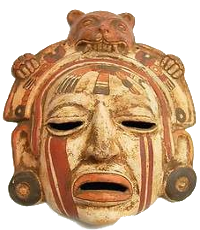North America
We rarely think of the North American continent, prior to the arrival of the Europeans, in political terms, and we never think of it as an international system in its own right. In our imagination the people living here — the “Indians” — spent all of their time chasing buffaloes and engaging in various forms of savage warfare. Since their societies lacked fixed territorial boundaries, they had no political or administrative institutions. Indeed, the very notion of history is inapplicable to societies such as these. Yet, as it turns out, none of these descriptions is true. In North America too there were plenty of sedentary societies, agriculturally-based kingdoms and large states which grew rich from trade conducted in far-flung networks that spanned the entirety of the continent. There are still many impressive monuments to be seen which provide testimony to these achievements. The fact that we know little about these societies is our fault, not theirs.
The first societies identified by historians are those which belong to the so-called “Woodland period,” which comprises the two millennia from 1000 BCE to about the year 1000 of the Common Era. These societies can be found in a geographical area that stretches from what now is eastern Canada down along the eastern United States to the Gulf of Mexico. The people of the Woodland period were hunters and gatherers and they used spears, bows, and blowguns in order to catch deer, moose, turkey, grouse, beavers, and raccoons. They did not, however, hunt buffaloes. There were indeed enormous herds of buffaloes grazing further out west, but since there were no horses in the Americas, these large animals were difficult to kill. [Read more: “The Columbian exchange“] In addition, the people of the Woodland period collected nuts, acorns, mushrooms, and wild berries; some rivers provided a continuous supply of fish and shellfish which made it possible to establish settled communities. In communities that controlled particularly rich fishing grounds, societies of differentiated social classes developed. The people of the Woodland period worked leather, made tools and used pottery.
After the Woodland period, archaeologists have identified a number of separate cultures, distinguished above all by their artwork and their funeral rites. The Adena culture is the name given to a number of societies in today’s Ohio, Indiana and West Virginia. Here archaeologists have found conical mounds that were used as burial sites and perhaps also for various ceremonial purposes. The dead were buried together with various goods, including copper bracelets, beads, and cups. The people of the Adena culture produced ritual objects used by shamans who sought to transform themselves into birds, wolves, bears, and deer. These societies were gradually replaced by the so-called Hopewell societies, 200-500, located further inland, in today’s Ohio and Illinois. The Hopewell societies continued to build conical mounds and they engaged in trade. Historians have talked about the “Hopewell exchange system,” which, judging by the many exotic products discovered here, must have connected much of the North American continent. In Hopewell societies, archaeologists have found shells from Florida, obsidian from the Rocky Mountains and mica — a mineral used for making pots — from Tennessee.
Although Hopewell societies began to decline around the year 500 CE, the mound-building tradition continued in the societies that flourished in the Mississippi River valley between 800 and 1600. The people of the Mississippian culture created large urban settlements, of which the city of Cahokia, in today’s Illinois, was the largest. The mound built at Cahokia reminds us of the pyramids that were built in Mexico at the same time. On top of the mound, wooden structures were erected which served as temples, burial sites, and centers for political administration. Cahokia was a chiefdom with sharp social distinctions. Here political and religious power was in the hands of a small elite. Ordinary people were farmers, growing corn, the staple food, but there were many craftsmen too. Again trade was important. The Cahokians traded with a number of satellite cities, but also with people as far west as the Rocky Mountains. They worshiped the sun, moon, and stars, but above all the Great Serpent — again there may be a connection to Mexico here. Cahokians used to wear amulets in the form of a falcon, perhaps to protect a warrior against the arrows of his enemy, or to assure health and many children. [Read more: “Moundbuilders of the Mississippi”]
Further west, in today’s New Mexico and Arizona, in the southwestern parts of the United States, we find the so-called “pueblo cultures.” Pueblo means “village” in Spanish, and the village-like structure of the settlements was the first thing that struck the Europeans when they arrived here in the sixteenth century. The houses consisted of apartments made in adobe and stone, with numerous rooms and courtyards built very near and on top of each other, sometimes creating apartment-style buildings four or five stories high. These structures made for a closely connected community, but in addition, the pueblos served as a defense against robbers and roving bands. The most elaborate pueblo settlement was that of Chaco Canyon in today’s New Mexico. [Read more: “The kivas of Chaco Canyon”]
There are today some 5 million people in the United States who count themselves as Native Americans, corresponding to less than 2 percent of the population of the country. In addition, there may be some 1.5 million Native Americans in Canada. There are 562 federally recognized tribal governments in the US. These “reservations” govern and police themselves and collect their own taxes. Many have recently opened casinos where they offer visitors Las Vegas-style gambling. Today only about a fifth of Native Americans live on reservations. There are twenty-one surviving and still inhabited pueblos in the southwestern United States. They are the oldest continuously inhabited communities in North America.



